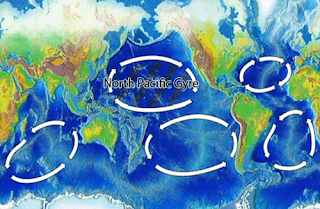 |
| Captain Moore, posing with a water sample taken from the Great Garbage Patch. Courtesy of Algalita Marine Research Foundation, Yale Scientific |
***
In Mythbuster: The Truth about the Great Pacific Garbage Patch author Taryn Laubenstein describes the Patch thus:From above the Pacific Ocean, all is calm. Blue water meets blue skies, each reflecting the other’s pure, infinite depths. But now a white scrap meanders by; not the reflection of a cloud, but a bobbing Styrofoam cup. Soon it is joined by two, now three, now ten, now fifty others, all jostling for space. They start to stack, forming hills, mountains. They support their plastic brethren: discarded bottles, packaging materials, webbed fishing nets. Worn-out tires pile atop one another forming rubber towers, while flimsy shopping bags flutter like flags in the breeze. It is an island of plastic the size of Texas, floating in the middle of the Pacific.
This is the image that comes to mind when people hear of the Great Pacific Garbage Patch: a massive, floating heap of debris. However, while it is true that trash does find its way into the oceans, the Great Pacific Garbage Patch is not a floating island in the traditional sense. Instead, the Garbage Patch is composed of tiny plastic bits that linger unseen beneath the surface, ranging in size from a few square inches to barely visible specks.The myth of a floating island of debris originated with its discoverer, Captain Charles Moore, in 1997. Also known as the Pacific trash vortex, it is one of five oceanic vortices where ocean currents trap pelagic plastics, chemical sludge and other debris. These vortices are called gyres.
***
 |
| Fangz, North Pacific Gyre World Map, Wikipedia |
***
In 2015 a trash-mapping expedition shed light on the 'Great Pacific Garbage Patch' by "measuring the size and mapping the location of tons of plastic waste floating between the west coast and Hawaii (The Guardian)." The sponsoring group, Ocean Cleanup, and its founder Boyan Slat have promised a report of findings by mid-2016.
Recently Slat's group tested its first trash-catching barriers in Dutch waters. Gizmag reports that by using a
natural system of circular ocean currents to push plastic waste into long floating arms and onwards into a central collection point, Slat's system would be highly energy efficient. He claims that it would cut the time required to clean up the oceans from millennia to mere years, and a positive feasibility study and US$2.1 million crowdfunding phase have since given him impetus to put his plan into action.
-- Marge

No comments:
Post a Comment